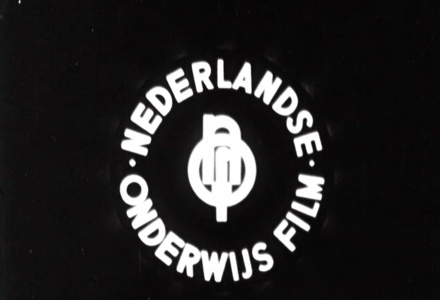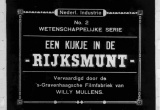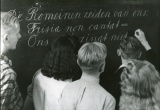NOF – Netherlands Foundation for Educational Films
School cinema visits deemed ‘inappropriate’
The school cinemas that were established in various Dutch cities in the twenties and thirties met with criticism from very early on. Some critics objected for moral reasons: they were convinced that children should not be pushed into going to the cinema, which was associated with ‘indecent’ behaviour. Others instead used pedagogical arguments. Teachers and educational experts believed it was inappropriate for students to leave the familiar settings of their classrooms during school hours – only to be at the mercy of a film lecturer who might have been enthusiastic, but wasn’t officially a teacher. They disapproved of school cinemas because they screened films that did not fit with the children’s lesson programme, prior knowledge and cognitive abilities.
The establishment of the NOF
In the early 1940s an increasing number of commentators argued that teachers should show films themselves, in their regular classrooms. In 1940, the Nederlandse Vereniging voor Culturele films (Dutch Association for Cultural Films), known nationally for promoting ‘high quality’ films, made a proposal: a federally subsidised organisation should be established that could distribute films suitable for screening in schools (a type known at the time as leerfilms – educational films).
A.A. Schoevers, the founder of a well-known chain of office training institutes, put words into action in 1941. In the middle of the occupation period, he created the Stichting Nederlandse Onderwijsfilm (NOF), which had the support of the Ministry of Education, Arts and Science. After the Second World War the organisation was ‘purged’, and after several changes in its board of directors, it was able to continue its activities without too many problems.
The first film screenings in schools
The NOF produced and distributed – and later acquired – films that, according to its founders, fit in seamlessly with the Dutch school curricula. In practice, these were titles that could be used as aids to the teaching of biology, geography, history and (foreign) languages (see NOF Films). In the early 1950s, when Jan Marie Peters was director of the institute, items that supported lessons in film studies were added to the NOF’s collection. In the beginning, the films the institute supplied were silent ones; it was not until the mid-1950s that sound films were added to the collection.
Schools paid contribution fees to the NOF that were based on the total number of students attending. This entitled teachers to ordering a film once every few weeks. In the early years, they were required to have a ‘user’s permit’ that showed they had the necessary technical and didactic skills to properly show the films. For purposes of film selection, they could use ‘instruction booklets’: brochures that were distributed with the films and that contained information on each item’s content and structure, advice about how it should be used, and sometimes a supplemental bibliography. The NOF also published manuals for teachers and, later on, catalogues of available titles.
Non-flammable film material
A factor that was of crucial importance to the use of films in classrooms was the development and distribution of non-flammable small gauge film. In the school cinema days, only highly flammable film material was used. Film had to be projected with heavy 35mm projectors that could only be operated by professionals.
The films that the NOF provided, in contrast, were all printed on 16mm acetate film. During the Second World War, this format and material developed into the standard for film projection outside of cinemas. In those years, 16mm films were used intensively for training, information and propaganda purposes, and this kept the projection equipment’s price down. Initially, many schools had to borrow equipment from the NOF, but as time passed, they could often afford to buy their own.
The use of educational films
As for the scale and nature of classroom film use, very little can be ascertained. According to the NOF’s own information, it served around 4,000 schools in the mid-1950s – so in theory, it could have catered to one-third of all Dutch students. While the NOF was definitely the largest supplier of what was known by then as ‘classroom films’, the intensity with which the films were used was uneven, varying not only from school to school but also from teacher to teacher. Moreover, the ways in which the films were screened were very diverse: some teachers followed the NOF’s guidelines to the letter and used them only to support their lessons while others used them purely for entertainment purposes. It was common for classroom films to be shown on holidays such as Sinterklaas and the Queen’s Birthday, or on the last few hours before a weekend or school holiday.
more information
If you are looking for more material from our collection, please contact Film Sales:
sales@eyefilm.nl
phone +31 (0)20 5891 426



